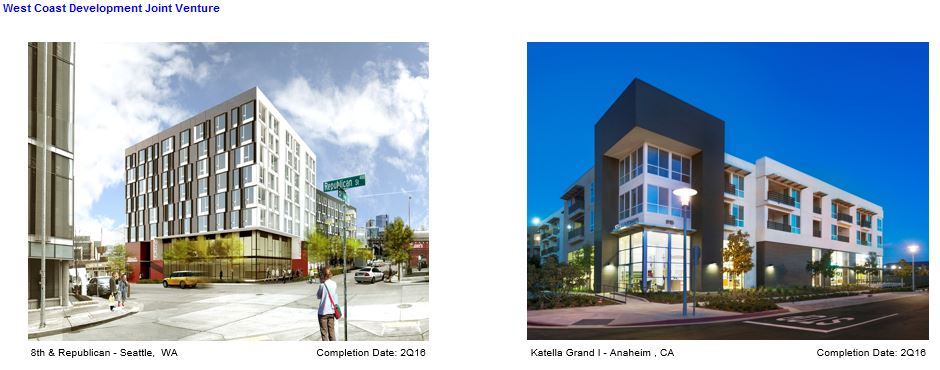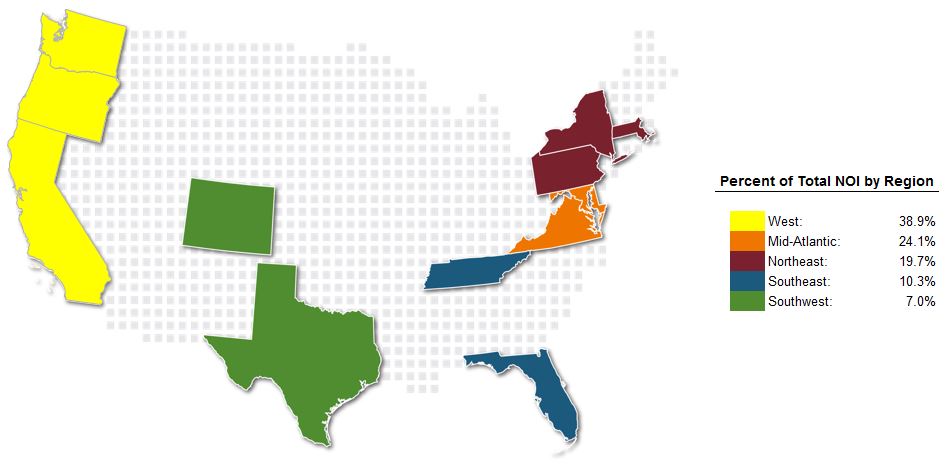|
| | | | | | | | | |
| | | | | | | | | |
| |
| | | | | | | | | |
| | |
| Attachment 16(A) |
| |
| UDR, Inc. |
| Definitions and Reconciliations |
| March 31, 2016 |
| (Unaudited) |
| | | | | | | | | | |
Acquired Communities: The Company defines Acquired Communities as those communities acquired by the Company, other than development and redevelopment activity, that did not achieve stabilization as of the most recent quarter. |
| | | | | | | | | | |
Adjusted Funds From Operations ("AFFO") attributable to common stockholders and unitholders: The Company defines AFFO as FFO as Adjusted attributable to common stockholders and unitholders less recurring capital expenditures that are necessary to help preserve the value of and maintain functionality at our communities. |
| | | | | | | | | | |
| Management considers AFFO a useful supplemental performance metric for investors as it is more indicative of the Company's operational performance than FFO or FFO as Adjusted. AFFO is not intended to represent cash flow or liquidity for the period, and is only intended to provide an additional measure of our operating performance. The Company believes that net income attributable to common stockholders is the most directly comparable GAAP financial measure to AFFO. Management believes that AFFO is a widely recognized measure of the operations of REITs, and presenting AFFO will enable investors to assess our performance in comparison to other REITs. However, other REITs may use different methodologies for calculating AFFO and, accordingly, our AFFO may not always be comparable to AFFO calculated by other REITs. AFFO should not be considered as an alternative to net income (determined in accordance with GAAP) as an indication of financial performance, or as an alternative to cash flows from operating activities (determined in accordance with GAAP) as a measure of our liquidity, nor is it indicative of funds available to fund our cash needs, including our ability to make distributions. A reconciliation from net income attributable to common stockholders to AFFO is provided on Attachment 2. |
| | | | | | | | | | |
Development Communities: The Company defines Development Communities as those communities recently developed or under development by the Company, that are currently majority owned by the Company and have not achieved stabilization as of the most recent quarter. |
| | | | | | | | | | |
Effective New Lease Rate Growth: The Company defines effective new lease rate growth as the increase in gross potential rent realized less all concessions for the new lease term (current effective rent) versus prior resident effective rent for the prior lease term on all new leases commenced during the current quarter. |
| | | | | | | | | | |
| Management considers effective new lease rate growth a useful metric for investors as it assesses market-level new demand trends. |
| | | | | | | | | | |
Effective Renewal Lease Rate Growth: The Company defines effective renewal lease rate growth as the increase in gross potential rent realized less all concessions for the new lease term (current effective rent) versus prior effective rent for the prior lease term on all renewed leases commenced during the current quarter. |
| | | | | | | | | | |
| Management considers effective renewal lease rate growth a useful metric for investors as it assesses market-level, in-place demand trends. |
| | | | | | | | | | |
Estimated Quarter of Completion: The Company defines estimated quarter of completion of a development or redevelopment project as the date on which construction is expected to be completed, but does not represent the date of stabilization. |
| | | | | | | | | | |
Fixed Charge Coverage Ratio: The Company defines Fixed Charge Coverage Ratio as net income, excluding the impact of interest expense, real estate depreciation and amortization of wholly owned and other joint venture communities, other depreciation and amortization, noncontrolling interests, net gain/(loss) on the sale of real estate owned, TRS income tax, divided by total interest plus preferred dividends. |
| | | | | | | | | | |
| Management considers fixed charge coverage a useful metric for investors as it provides ratings agencies, investors and lending partners with a widely-used measure of the Company’s ability to service its debt obligations as well as compare leverage against that of its peer REITs. A reconciliation of the components that comprise fixed charge coverage is provided on Attachment 4(C) of the Company's quarterly supplemental disclosure. |
| | | | | | | | | | |
Funds From Operations as Adjusted attributable to common stockholders and unitholders: The Company defines FFO attributable to common stockholders and unitholders as Adjusted as FFO excluding the impact of acquisition-related costs and other non-comparable items including, but not limited to, prepayment costs/benefits associated with early debt retirement, gains on sales of marketable securities and TRS property, deferred tax valuation allowance increases and decreases, casualty-related expenses and recoveries, severance costs and legal costs. |
| | | | | | | | | | |
| Management believes that FFO as Adjusted is useful supplemental information regarding our operating performance as it provides a consistent comparison of our operating performance across time periods and allows investors to more easily compare our operating results with other REITs. FFO as Adjusted is not intended to represent cash flow or liquidity for the period, and is only intended to provide an additional measure of our operating performance. The Company believes that net income attributable to common stockholders is the most directly comparable GAAP financial measure to FFO as Adjusted. However, other REITs may use different methodologies for calculating FFO as Adjusted or similar FFO measures and, accordingly, our FFO as Adjusted may not always be comparable to FFO as Adjusted or similar FFO measures calculated by other REITs. FFO as Adjusted should not be considered as an alternative to net income (determined in accordance with GAAP) as an indication of financial performance, or as an alternative to cash flows from operating activities (determined in accordance with GAAP) as a measure of our liquidity. A reconciliation from net income attributable to common stockholders to FFO as Adjusted is provided on Attachment 2. |
| | | | | | | | | | |
Funds From Operations ("FFO") attributable to common stockholders and unitholders: The Company defines FFO as net income attributable to common stockholders and unitholders, excluding impairment write-downs of depreciable real estate or of investments in non-consolidated investees that are driven by measurable decreases in the fair value of depreciable real estate held by the investee, gains (or losses) from sales of depreciable property, plus real estate depreciation and amortization, and after adjustments for noncontrolling interests, unconsolidated partnerships and joint ventures. This definition conforms with the National Association of Real Estate Investment Trust's definition issued in April 2002. In the computation of diluted FFO, unvested restricted stock, unvested LTIP units, stock options, and the shares of Series E Cumulative Convertible Preferred Stock are dilutive; therefore, they are included in the diluted share count. |
| | | | | | | | | | |
| Activities of our taxable REIT subsidiary (TRS), include development and land entitlement. From time to time, we develop and subsequently sell a TRS property which results in a short-term use of funds that produces a profit that differs from the traditional long-term investment in real estate for REITs. We believe that the inclusion of these TRS gains in FFO is consistent with the standards established by NAREIT as the short-term investment is incidental to our main business. TRS gains on sales, net of taxes, are defined as net sales proceeds less a tax provision and the gross investment basis of the asset before accumulated depreciation. |
| | | | | | | | | | |
| Management considers FFO a useful metric for investors as the Company uses FFO in evaluating property acquisitions and its operating performance and believes that FFO should be considered along with, but not as an alternative to, net income and cash flow as a measure of the Company's activities in accordance with GAAP. FFO does not represent cash generated from operating activities in accordance with GAAP and is not necessarily indicative of funds available to fund our cash needs. A reconciliation from net income attributable to common stockholders to FFO is provided on Attachment 2. |
| | | | | | | | | | |
Held For Disposition Communities: The Company defines Held for Disposition Communities as those communities that were held for sale as of the end of the most recent quarter. |
| | | | | | | | | | |
Interest Coverage Ratio: The Company defines Interest Coverage Ratio as net income, excluding the impact of interest expense, real estate depreciation and amortization of wholly owned and joint venture communities, other depreciation and amortization, noncontrolling interests, net gain/(loss) on the sale of real estate owned, TRS income tax, divided by total interest. |
| | | | | | | | | | |
| Management considers interest coverage ratio a useful metric for investors as it provides ratings agencies, investors and lending partners with a widely-used measure of the Company’s ability to service its debt obligations as well as compare leverage against that of its peer REITs. A reconciliation of the components that comprise interest coverage ratio is provided on Attachment 4(C) of the Company's quarterly supplemental disclosure. |


